An Improved Impact Source Locating System Using FBG Rosette Array †
Abstract
1. Introduction
2. Experimental and Analysis Procedures
2.1. Impact Testing and Sensor Layout
2.2. Fiber Bragg grating (FBG) Interrogating Schemes
2.2.1. Amplified spontaneous emission Light Source with Tunable Edge Filter
2.2.2. Tunable Fiber Ring Laser
2.2.3. Impact Source Locating Algorithm
3. Results and Discussion
3.1. Signal Strength of the Two Interrogation Schemes
3.2. Angular Sensitivities for Different Fiber Bragg Grating Rosette Configurations
3.3. Impact Source Localization
4. Conclusions
Author Contributions
Funding
Acknowledgments
Conflicts of Interest
References
- Harris, C. Avoiding Future Pipeline Failures through Detecting, Identifying, Prioritizing Mechanical Damage. In Proceedings of the Pipeline Technology Conference, Berlin, Germany, 2–4 May 2017. [Google Scholar]
- Gao, M.; Krishnamurthy, R. Mechanical Damage in Pipelines: A Review of the Methods and Improvements in Characterization, Evaluation, and Mitigation. In Oil and Gas Pipelines; John Wiley & Sons: Hoboken, NJ, USA, 2015; pp. 289–326. [Google Scholar] [CrossRef]
- Kreculj, D.; Rasuo, B. Review of Impact Damages Modelling in Laminated Composite Aircraft Structures. TehničkiVjesnik 2013, 20, 485–495. [Google Scholar]
- Horace, L. On Waves in an Elastic Plate. Proc. R. Soc. Lond. Ser. A Contain. Pap. Math. Phys. Character 1917, 93, 114–128. [Google Scholar]
- Schubert, K.J.; Brauner, C.; Herrmann, A.S. Non-Damage-Related Influences on Lamb Wave–Based Structural Health Monitoring of Carbon Fiber–Reinforced Plastic Structures. Struct. Health Monit. 2014, 13, 158–176. [Google Scholar] [CrossRef]
- Tobias, A. Acoustic-Emission Source Location in Two Dimensions by an Array of Three Sensors. Non Destr. Test. 1976, 9, 9–12. [Google Scholar] [CrossRef]
- Liang, D.; Yuan, S.; Liu, M. Distributed Coordination Algorithm for Impact Location of Preciseness and Real-Time on Composite Structures. Measurement 2013, 1, 527–536. [Google Scholar] [CrossRef]
- Kundu, T.; Das, S.; Jata, K.V. Point of Impact Prediction in Isotropic and Anisotropic Plates from the Acoustic Emission Data. J. Acoust. Soc. Am. 2007, 122, 2057–2066. [Google Scholar] [CrossRef]
- Jiao, J.; He, C.; Wu, B.; Fei, R.; Wang, X. Application of Wavelet Transform on Modal Acoustic Emission Source Location in Thin Plates with One Sensor. Int. J. Press. Vessel. Pip. 2004, 81, 427–431. [Google Scholar] [CrossRef]
- Toyama, N.; Koo, J.H.; Oishi, R.; Enoki, M.; Kishi, T. Two-Dimensional AE Source Location with Two Sensors in Thin CFRP Plates. J. Mater. Sci. Lett. 2001, 20, 1823–1825. [Google Scholar] [CrossRef]
- Chiariotti, P.; Martarelli, M.; Castellini, P. Acoustic Beamforming for Noise Source Localization—Reviews, Methodology and Applications. Mech. Syst. Signal Process. 2019, 120, 422–448. [Google Scholar] [CrossRef]
- McLaskey, G.C.; Glaser, S.D.; Grosse, C.U. Beamforming Array Techniques for Acoustic Emission Monitoring of Large Concrete Structures. J. Sound Vib. 2010, 329, 2384–2394. [Google Scholar] [CrossRef]
- He, T.; Pan, Q.; Liu, Y.; Liu, X.; Hu, D. Near-Field Beamforming Analysis for Acoustic Emission Source Localization. Ultrasonics 2012, 52, 587–592. [Google Scholar] [CrossRef] [PubMed]
- Perez, I.M.; Cui, H.; Udd, E. Acoustic Emission Detection Using Fiber Bragg Gratings. In Smart Structures and Materials 2001: Sensory Phenomena and Measurement Instrumentation for Smart Structures and Materials; International Society for Optics and Photonics: Bellingham, WA, USA, 2001; Volume 4328, pp. 209–216. [Google Scholar] [CrossRef]
- Betz, D.C.; Thursby, G.; Culshaw, B.; Staszewski, W.J. Acousto-Ultrasonic Sensing Using Fiber Bragg Gratings. Smart Mater. Struct. 2003, 12, 122–128. [Google Scholar] [CrossRef]
- Chen, B.L.; Shin, C.S. Fiber Bragg Gratings Array for Structural Health Monitoring. Mater. Manuf. Process. 2010, 25, 255–258. [Google Scholar] [CrossRef]
- Kirkby, E.; de Oliveira, R.; Michaud, V.; Månson, J.A. Impact Localisation with FBG for a Self-Healing Carbon Fibre Composite Structure. Compos. Struct. 2011, 94, 8–14. [Google Scholar] [CrossRef]
- Kirikera, G.R.; Balogun, O.; Krishnaswamy, S. Adaptive Fiber Bragg Grating Sensor Network for Structural Health Monitoring: Applications to Impact Monitoring. Struct. Health Monit. 2011, 10, 5–16. [Google Scholar] [CrossRef]
- Sai, Y.; Jiang, M.; Sui, Q.; Jia, L.; Lu, S. Low Velocity Impact Localization System Using FBG Array and MVDR Beamforming Algorithm. Photonic Sens. 2015, 5, 357–364. [Google Scholar] [CrossRef][Green Version]
- Tian, Z.; Yu, L.; Sun, X.; Lin, B. Damage localization with fiber Bragg grating Lamb wave sensing through adaptive phased array imaging. Struct. Health Monit. 2019, 18, 334–344. [Google Scholar] [CrossRef]
- Betz, D.C.; Thursby, G.; Culshaw, B.; Staszewski, W.J. Lamb Wave Detection and Source Location Using Fiber Bragg Grating Rosettes. In Smart Structures and Materials 2003: Smart Sensor Technology and Measurement Systems; International Society for Optics and Photonics: Bellingham, WA, USA, 2003; Volume 5050, pp. 117–128. [Google Scholar] [CrossRef]
- Majewska, K.; Opoka, S.; Kudela, P.; Ostachowicz, W. Novel FBG Rosette for Determining Impact Location in Thin Plate-like Structure. J. Phys. Conf. Ser. 2015, 628, 012118. [Google Scholar] [CrossRef]
- O’Keefe, B. Finding Location with Time of Arrival and Time Difference of Arrival Techniques. ECE Senior Capstone Project 2017 Tech Notes, ECE ’17; The Department of Electrical and Computer Engineering, Tufts University: Boston, MA, USA, 2017; Available online: https://sites.tufts.edu/eeseniordesignhandbook/files/2017/05/FireBrick_OKeefe_F1.pdf (accessed on 30 May 2019).
- Magne, S.; Rougeault, S.; Vilela, M.; Ferdinand, P. State-of-Strain Evaluation with Fiber Bragg Grating Rosettes: Application to Discrimination between Strain and Temperature Effects in Fiber Sensors. Appl. Opt. 1997, 36, 9437–9447. [Google Scholar] [CrossRef]
- Kundu, T. Acoustic Source Localization. Ultrasonics 2014, 54, 25–38. [Google Scholar] [CrossRef]
- Giurgiutiu, V.; Roman, C.; Lin, B.; Frankforter, E. Omnidirectional Piezo-Optical Ring Sensor for Enhanced Guided Wave Structural Health Monitoring. Smart Mater. Struct. 2014, 24, 015008. [Google Scholar] [CrossRef]
- Wu, Q.; Okabe, Y.; Yu, F. Ultrasonic Structural Health Monitoring Using Fiber Bragg Grating. Sensors 2018, 18, 3395. [Google Scholar] [CrossRef] [PubMed]
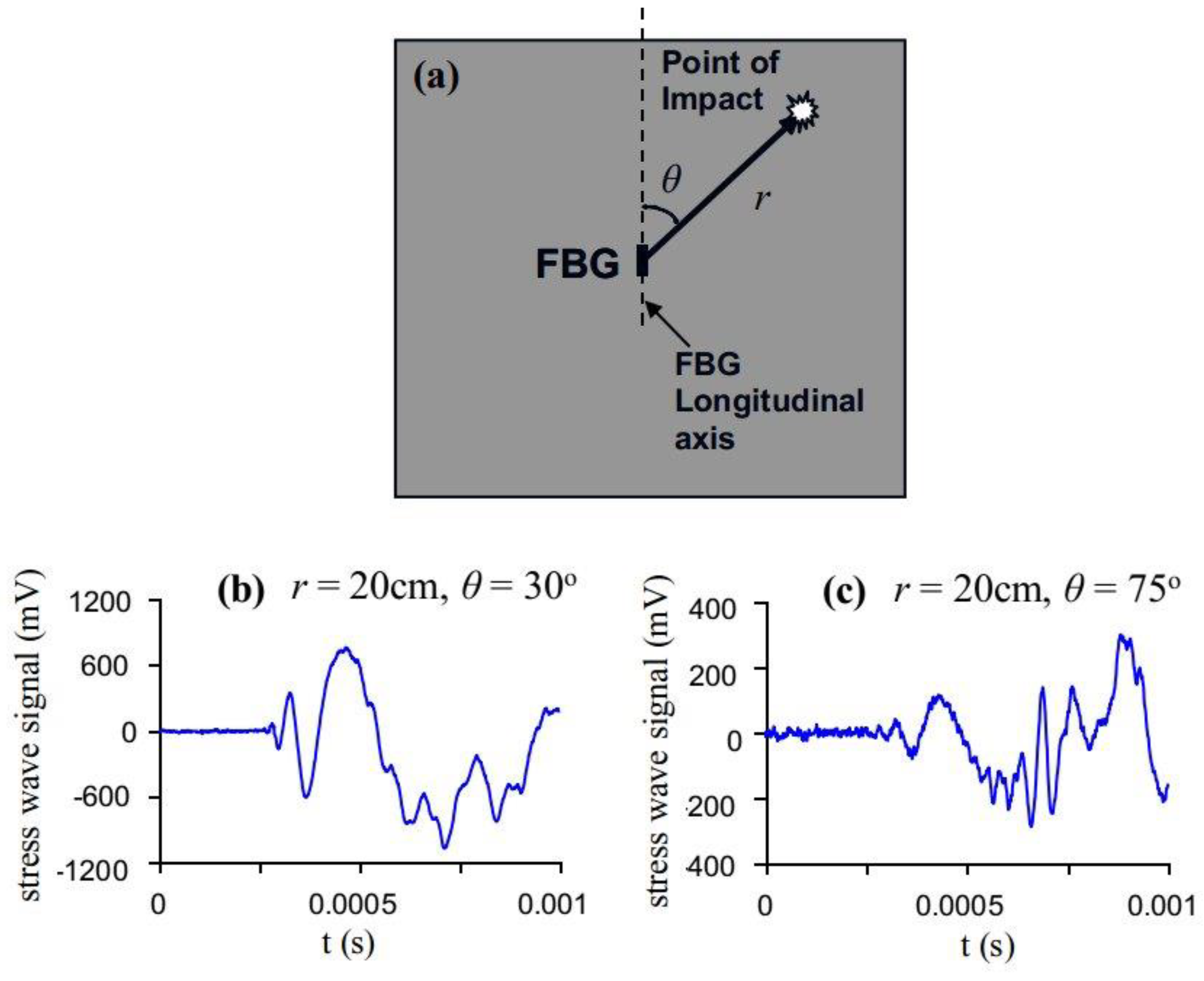
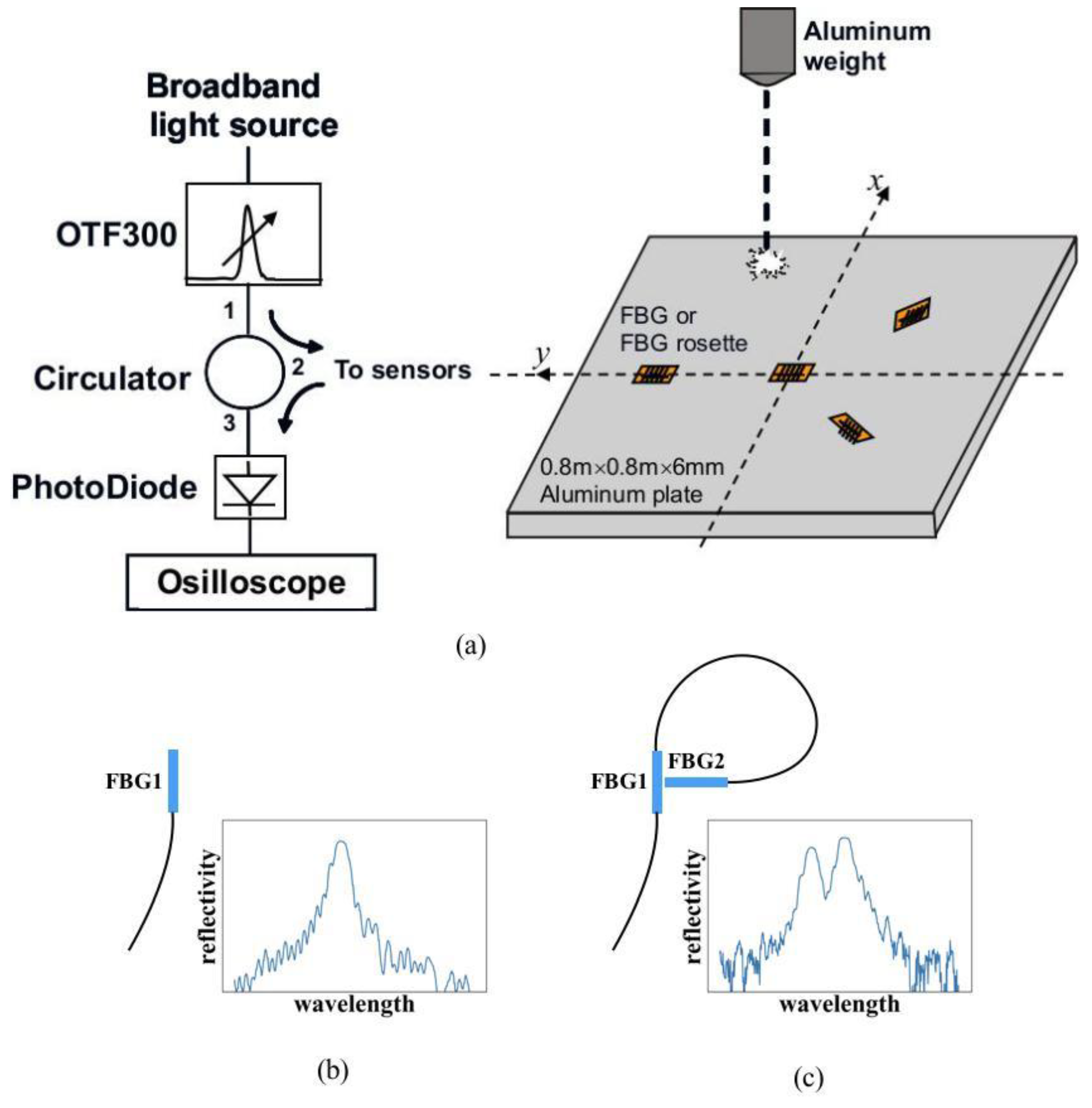

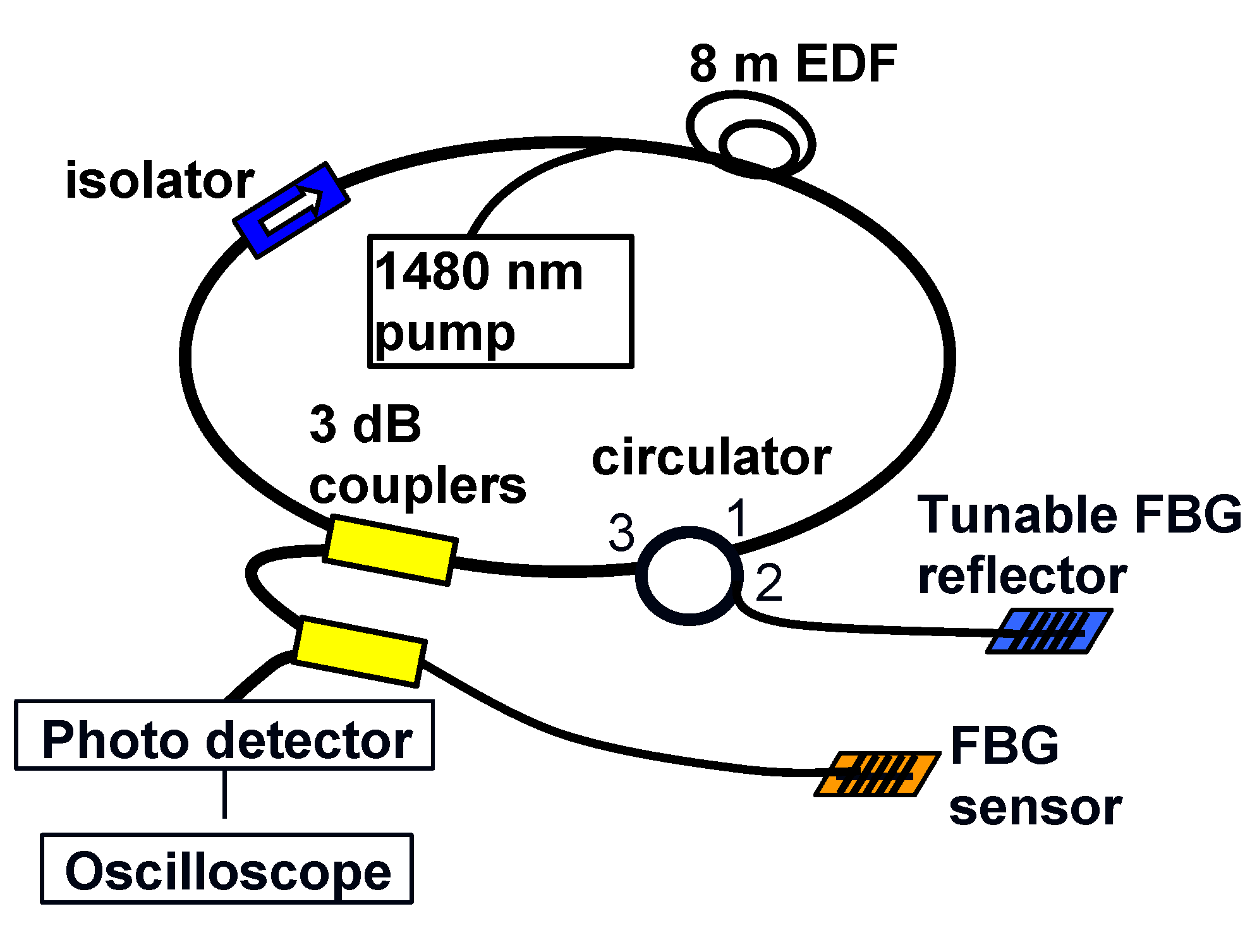


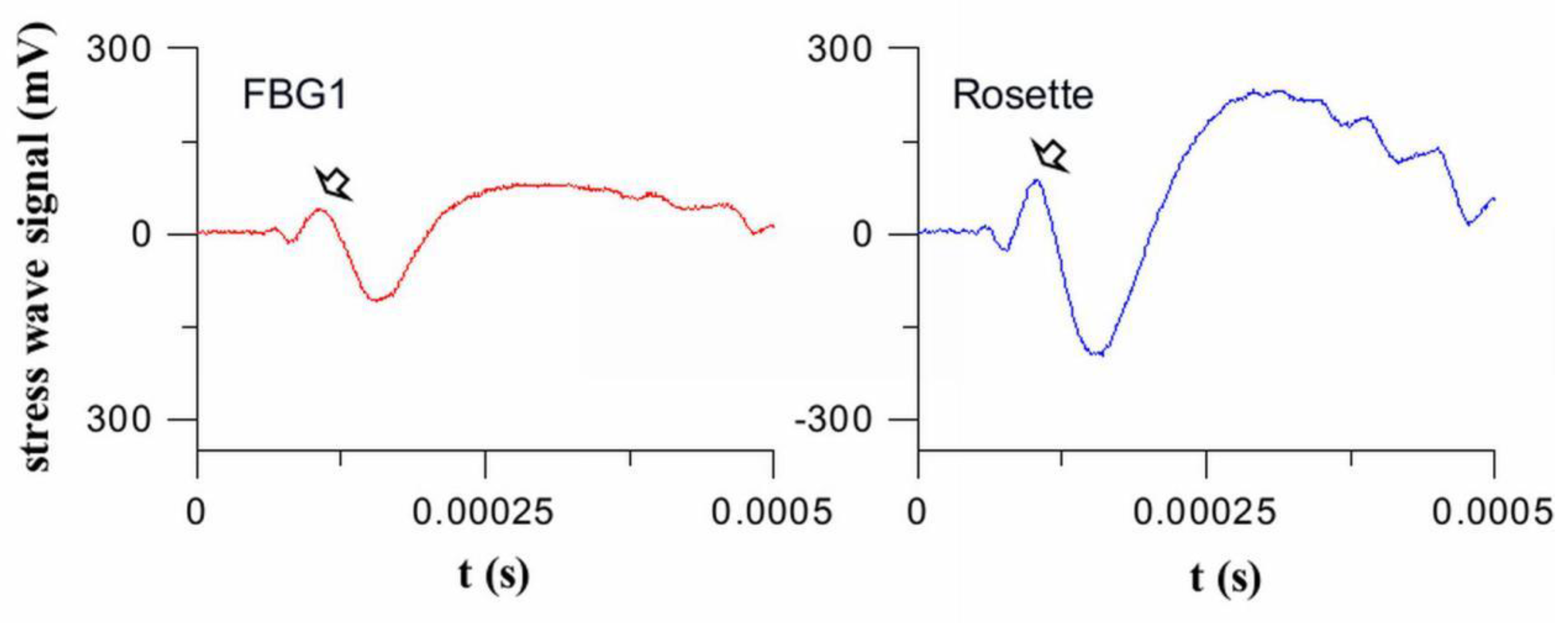
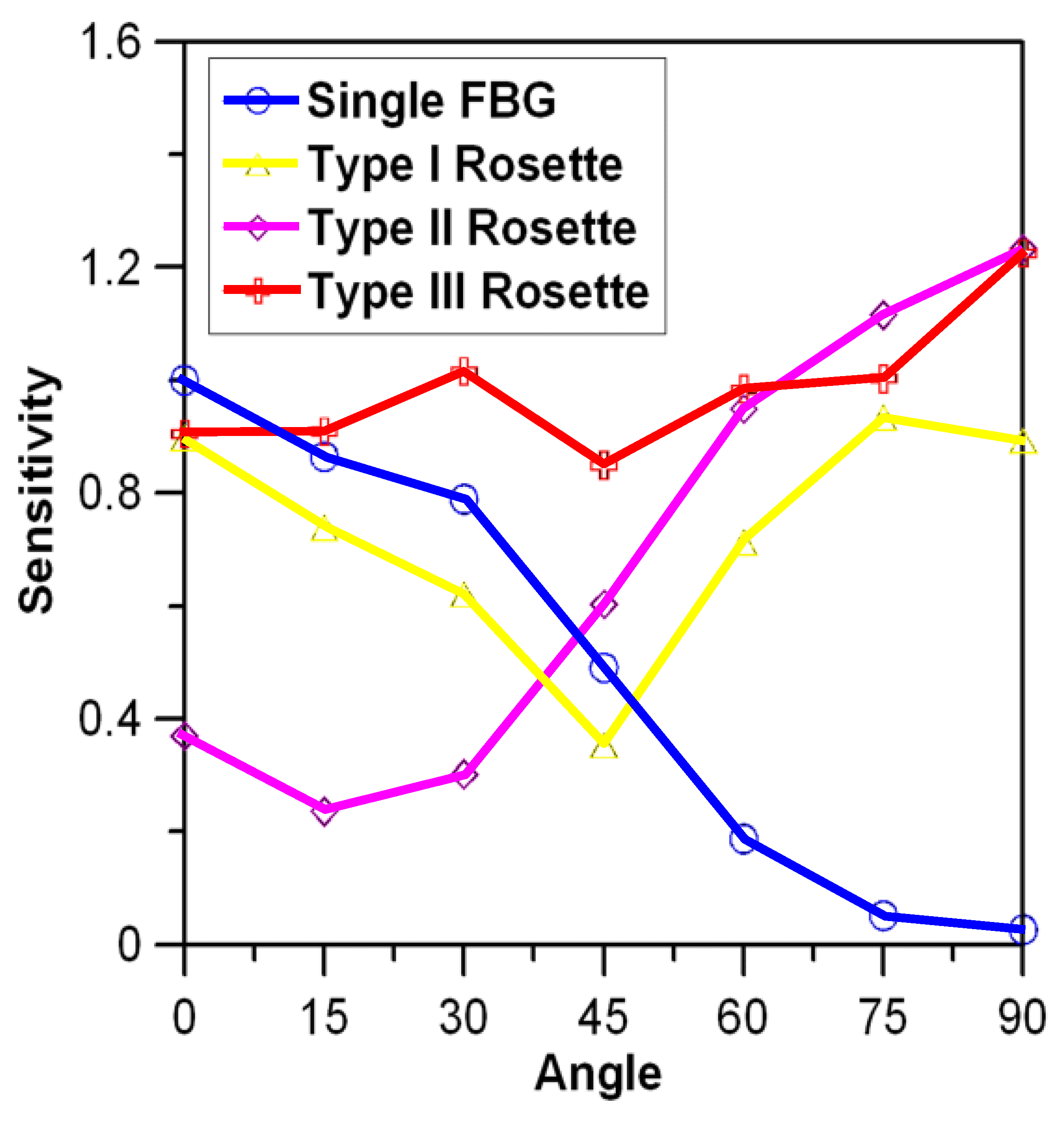


© 2019 by the authors. Licensee MDPI, Basel, Switzerland. This article is an open access article distributed under the terms and conditions of the Creative Commons Attribution (CC BY) license (http://creativecommons.org/licenses/by/4.0/).
Share and Cite
Chen, B.-L.; Shin, C.-S. An Improved Impact Source Locating System Using FBG Rosette Array. Sensors 2019, 19, 3453. https://doi.org/10.3390/s19163453
Chen B-L, Shin C-S. An Improved Impact Source Locating System Using FBG Rosette Array. Sensors. 2019; 19(16):3453. https://doi.org/10.3390/s19163453
Chicago/Turabian StyleChen, Bo-Lian, and Chow-Shing Shin. 2019. "An Improved Impact Source Locating System Using FBG Rosette Array" Sensors 19, no. 16: 3453. https://doi.org/10.3390/s19163453
APA StyleChen, B.-L., & Shin, C.-S. (2019). An Improved Impact Source Locating System Using FBG Rosette Array. Sensors, 19(16), 3453. https://doi.org/10.3390/s19163453



